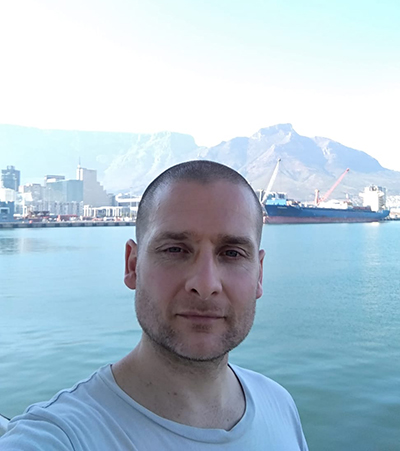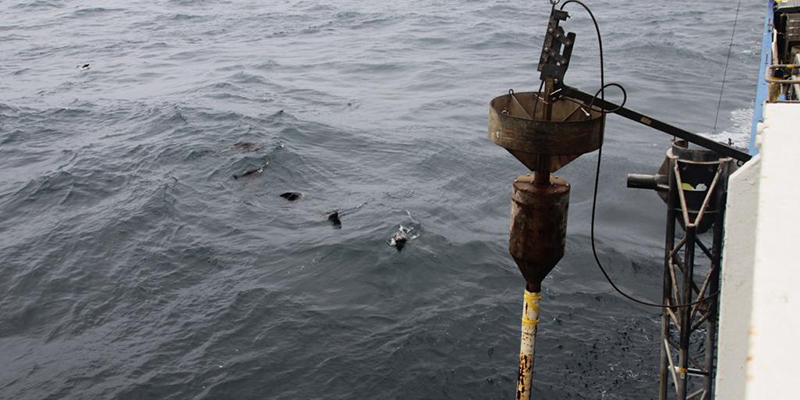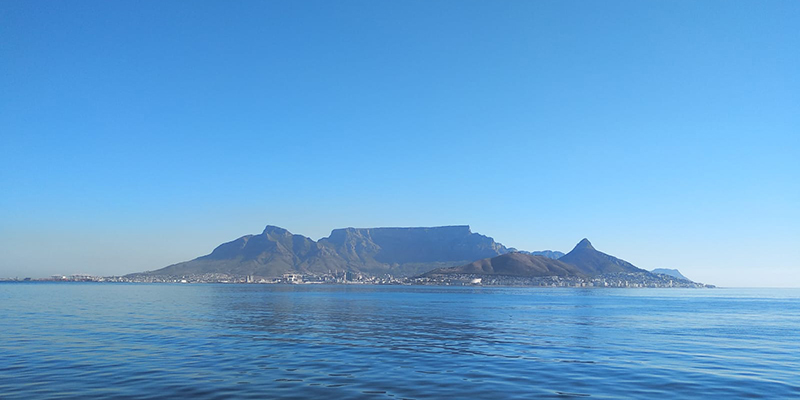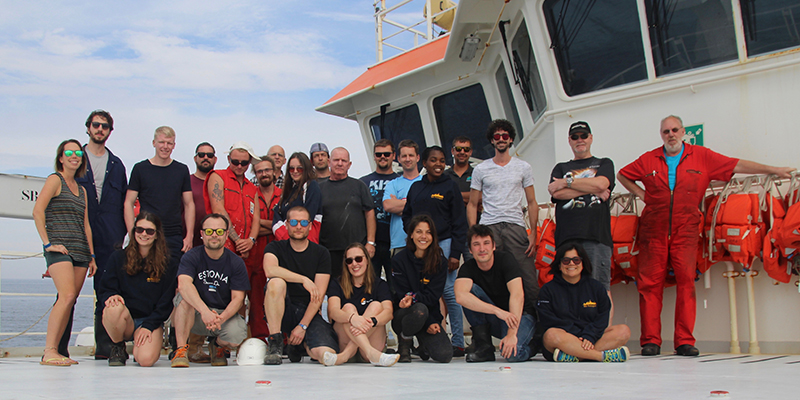
Febuary 25th | FUNAMOX Wrap up
As the ship came into port in Walvis Bay on February 13th, it was time for more than half of the scientific party (and all of the deck crew) to say goodbye to RV Pelagia and to the samples we collected over the last three weeks. FUNAMOX was an incredibly successful cruise, both in the science we were able to complete, and the collaborative spirit that we had throughout the time we spent here. I am in awe of how great the atmosphere was on board. Whether subsampling in cold lab containers late into the evening, or getting wet the next morning from collecting CTD water on little sleep (from said subsampling), everyone was happy to help out and to be part of this team. Chief scientist Peter Kraal always looked proud as a peacock as the science crew processed all water and sediment samples as soon as they hit the deck with the determination and proficiency of a well-trained Special Forces outfit. Even sticking in excess of 5000 identification labels onto an array of (tiny) vials and bottles for all kinds of samples that were stored for later analysis did not seem to affect the mood. Well, not too much…
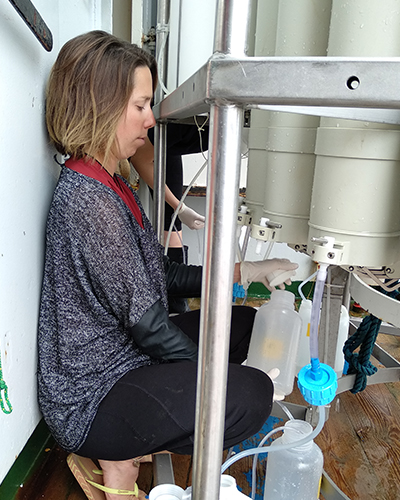
We managed to (1) deploy two moorings with sediment traps, which will monitor the formation of the oxygen deficient zones on the shelf and in deeper waters; (2) collect water and sediment for on board incubations to determine the rates of key biogeochemical processes such as O2 consumption and N transformations, as well as biomarker and pore water analyses and (3) filter hundreds of litres of water in situ to see what microorganisms are living in these oxygen starved waters and what they’re doing here. All of our work was done to better understand the biogeochemical cycling of the nutrients carbon, nitrogen and phosphorus and essential trace metals in the Benguela Upwelling System (BUS) off the coast of Namibia.
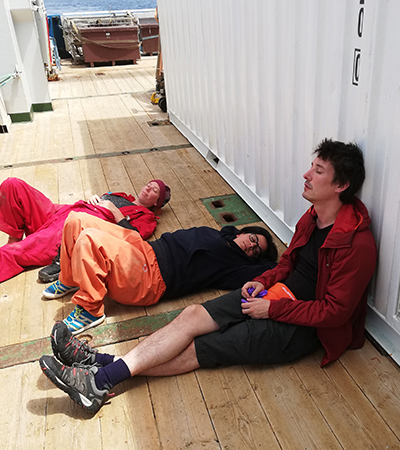
Fortunately, I am one of the lucky few who get to stay on board the Pelagia, as we continue with our adventures in the BUS. I’ll be acting as chief scientist, in the place of Furu Mienis, as we head north to deep-water coral provinces. Hopefully, we’ll find some living corals at the same time as we carry on sampling the water column and sediments to understand the geochemistry in this oxygen-deficient marine region. Please keep following us as the participants of leg 64PE450 make more scientific advances (the blogs have already started…).
Darci Rush – Organic geochemist, Marine Microbiology and Biogeochemistry department, NIOZ
February 9th | A great catch from the past
FUNAMOX expedition, RV Pelagia, 5th of February 2019, 1 PM. The stress in the wet lab – where all scientists are waiting – is rising. The piston core is in free fall and is about to hit the seafloor any second now. Everybody is silent. Some seconds later, Robin slowly increases tension on the cable to pull up the core device. The stress on the cable is clearly increasing, which is a good sign, as it means that the core must have penetrated the sediment. Slowly but steadily the cable is reeled in, until the tension – in a split second – drops. Some 750 meters below us, we just pulled out a whopping 12-meter long core tube out of the deep-sea muds. With 60 meters per minute, we start to reel in our precious catch, like a fisherman reeling in a big fish. For us, our big fish will hopefully contain a long and rich archive of past environmental conditions in the Namibian upwelling area.
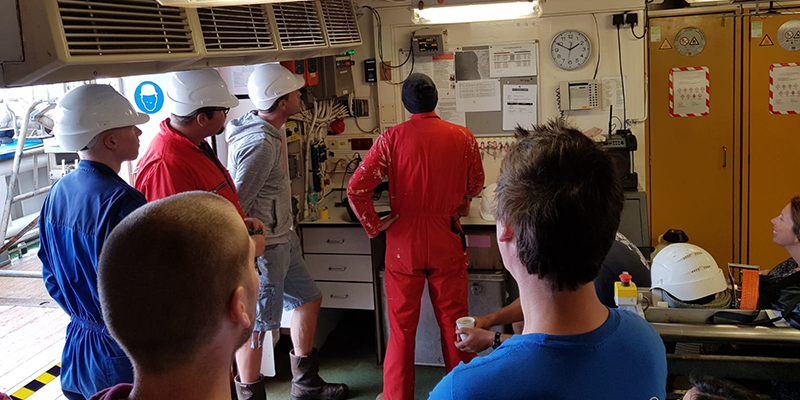
At present – that is the 9th of February – we are sampling the 7th Station of the FUNAMOX expedition. By being onboard of the sweet RV Pelagia for two weeks, we evolved into a smooth sampling machine. By now all routines are established. Wake up, breakfast at 7-8 AM, water-column sampling with CTD at 8-10 AM, sediment sampling with the multi corer at 10-12.30 PM, lunch at 12.30-13.00 PM, followed by an afternoon full of in-situ pumping, dinner at 18-18.30 PM with further sample processing as a dessert, sleep… wake up, repeat. Occasionally this “standard” work is intertwined with some serious seal watching (there are so many), exciting seafloor videoing, and cutting of the long piston cores that we love so much.
The great catch that we caught earlier this expedition is now safely stored in one of the fridges in the ships belly. Sad thing about being someone who studies the past oceanographic conditions (a so-called paleoceanographer) is that sample processing is mostly done back home. Revealing the environmental mysteries locked in these smelly muds will thus need to wait upon arrival of the material on Texel in May.
Zeynep Erdem – paleoceanographer, Marine Microbiology and Biogeochemistry department, NIOZ
Rick Hennekam – paleoceanographer, Ocean Systems department, NIOZ
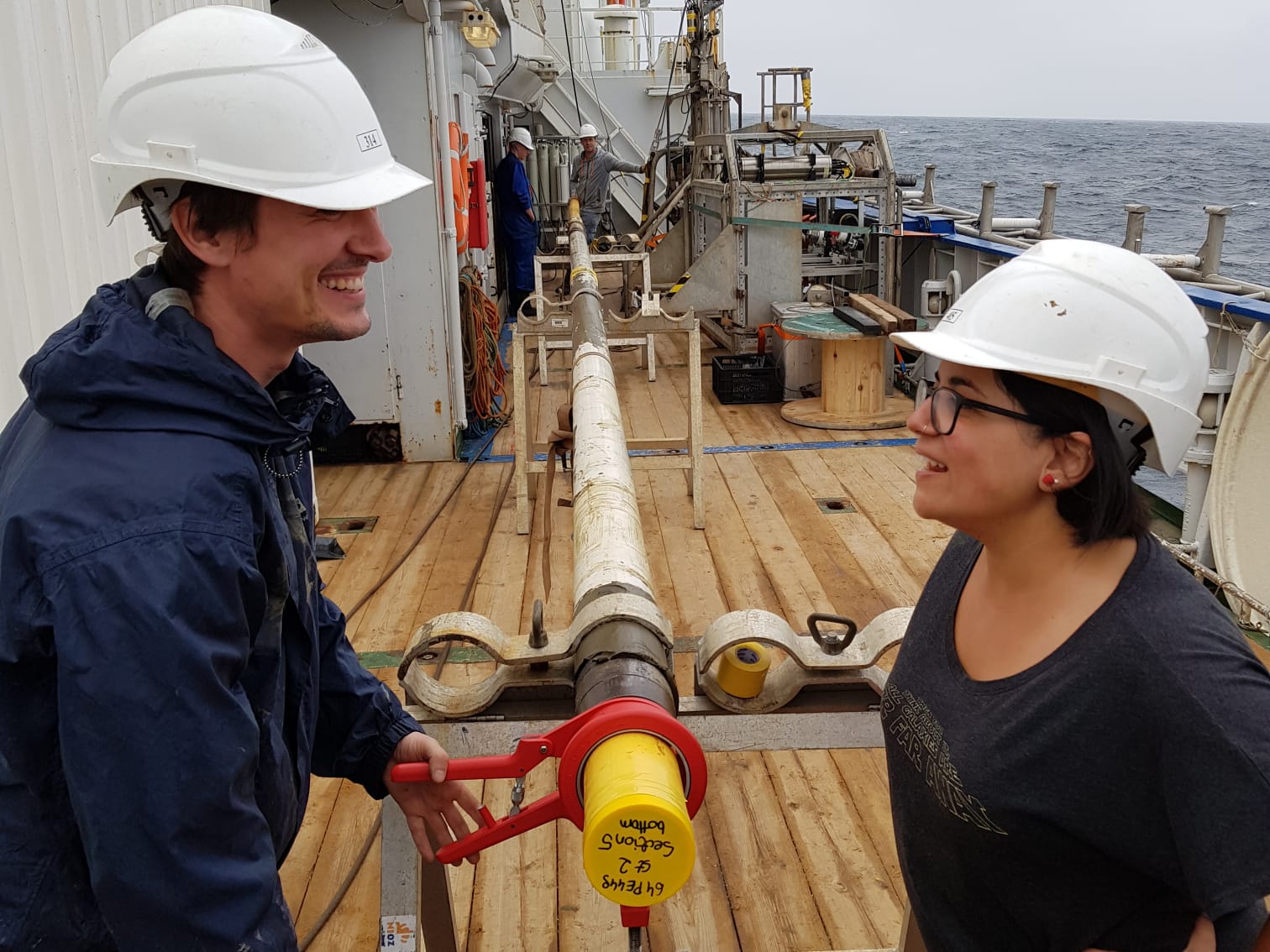
February 2nd | Trace metals in smelly muds – the first station
The pungent scent of rotten eggs fills our nostrils as the first sediment cores arrive on deck. In any other setting, this smell would not be greeted with a lot of enthusiasm, but this time things are a little different – the smelly muds, taken from the seafloor, are part of the reason we are here. On board of the RV Pelagia, we have reached the first sampling location of the FUNAMOX 2019 research cruise, just off the coast of Walvis Bay, Namibia. Now based in Zürich, I have joined my old[1] friends from the NIOZ for my first ever research cruise.
I awkwardly try to find my balance on the wobbling ship while we carefully move the sediment cores to the on-board laboratories. The labs are built into shipping containers and are designed to simulate the conditions at the ocean floor, including a temperature of 4 degrees Celsius and the lack of daylight. Just outside the containers, clear blue skies, impressive views of the ocean, and a comfortable 25–30 degrees Celsius are waiting. The contrast with conditions in the lab is a little frustrating, but there is no time to waste – we have to process the freshly recovered sediments quickly. In the container, without a view on the horizon, I get a little nauseous from the ship’s dance on the waves – or is it the smell? Regardless, my hands are stuck in a glovebag, a piece of equipment we use to prevent any oxygen from reaching our samples.
[1] Actually, with an average age of 30, this is likely one of the youngest scientific crews to ever board the Pelagia.
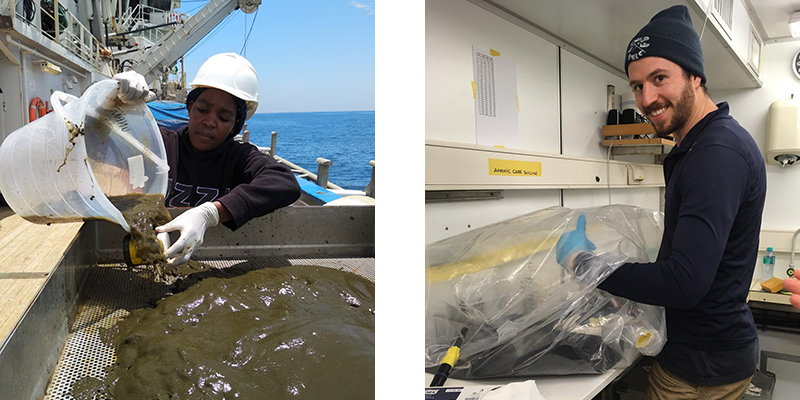
This anoxic sampling environment mimics conditions at the ocean floor, 130 meters below us, where our samples are from. There, due to the complete lack of oxygen, the conditions are too extreme for most organisms to live. Yet, some thrive in this environment, including specialised micro-organisms that produce H2S – responsible for the rotten egg smell. We are here to study the complex interplay of the biological and chemical processes that occur in these environments. This research is particularly relevant now, as human’s impact on global climate and coastal environments have caused a steady decline in the global oceanic oxygen content in the last few decades.
My perspective on this region is perhaps slightly different from that of the others on-board. Until recently, I was studying periods in Earth’s history, many million years ago, where low oxygen concentrations in the ocean were actually relatively common. These time intervals were associated with major changes to global climate and environment, with many aspects similar to our currently changing conditions. In order to understand how and why environmental conditions have changed in the past, and how they may change in the future, we require a detailed understanding of all processes involved. And that is exactly why we are here, floating in Namibian waters – this location provides an excellent natural laboratory with a wide variety of conditions.
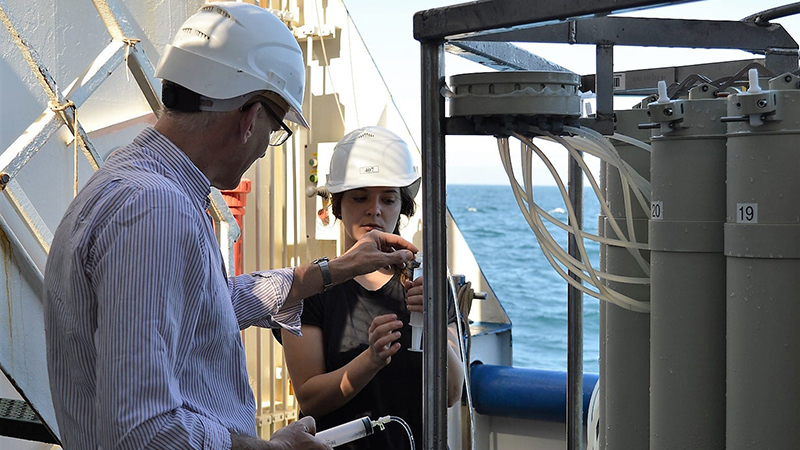
In the container, the chief-scientist’s home-mixed techno beats blast through the speakers to accompany the repetitive motions of core sampling. My specific purpose on the ship is the study of trace metals and their behaviour in these dynamic and low-oxygen environments, so I have to take extra care not to contaminate my samples. Trace elements only occur in small quantities in our oceans, but are often essential to (marine) life. The lack of oxygen, as found in the Namibian waters and sediments, changes the geochemical behaviour of these elements, which may have a profound impact on life in the oceans.
At 3 AM I finish processing the samples we recovered on our first day. I struggle to stay awake as I prepare for the next day and quietly waddle to my cabin. It has been a long day of sampling. The ship gently cradles me to sleep, preparing me for day 2 tomorrow. In essence, it will be more of the same. But, with the conditions out on the ocean rapidly changing and a vast territory of unexplored waters below us, we never know exactly what tomorrow will bring – it is what makes this research so exciting.
Tim Sweere – geochemist, Department of Earth Sciences, ETH Zürich
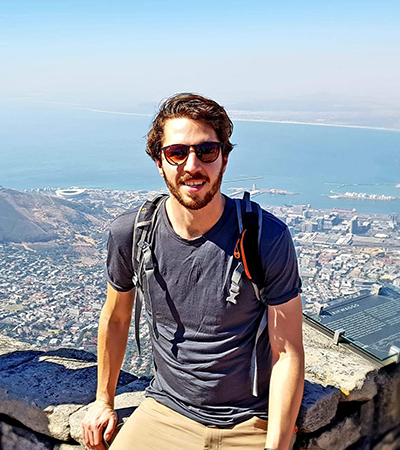
January 30th | Welcome to the FUNAMOX expedition!
And then all of a sudden you find yourself on the ocean. On research vessel (RV) Pelagia, which is sailing the fascinating southeast Atlantic off Africa, where cold deep waters reach the surface and provide nutrients that fuel abundant algal growth. This supply of nutrients, and its impact on the biological and chemical (biogeochemical) conditions in the water and on the seafloor, is subject of our FUNAMOX expedition (or, less appealing, 64PE449). FUNAMOX stands for “Biogeochemical functioning in Namibian oxygen-depleted waters”. With a research team of ten scientists supported by two technical engineers, a chemical analyst and a dedicated ship’s crew of 12. Under the blistering African summer sun, the wintery and snow-covered Netherlands that we left only a few days ago seems so far away.
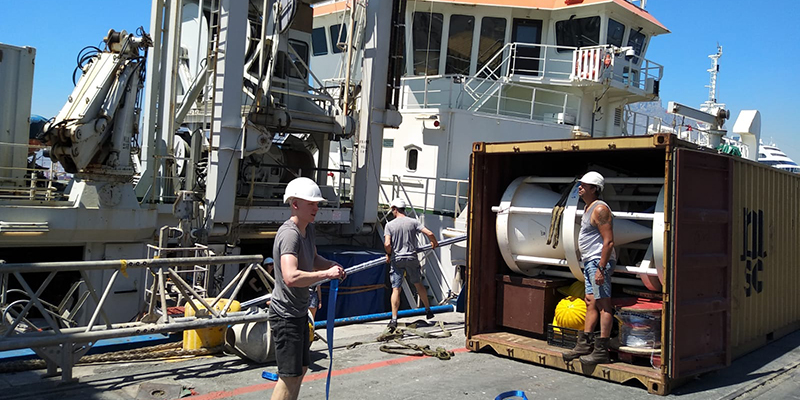
We are here on a mission. Our goal for the coming two weeks is to collect samples from the waters and sediments off-coast Namibia, where the decomposition of all those algae that thrive on the nutrients upwelled from the deep requires so much oxygen that it becomes depleted. Oxygen depletion makes it harder, and sometimes impossible, for higher organisms to thrive as these require oxygen to breathe. In extreme cases, “dead zones” are formed that are deprived of all life except microorganisms that can ”breathe” other substances than oxygen. And this depletion of oxygen completely alters the way that important elements such as carbon, nitrogen, phosphorus and essential trace metals are used and transformed. And by applying state-of-the-art analyses to the samples we are collecting, we aim to elucidate these processes.
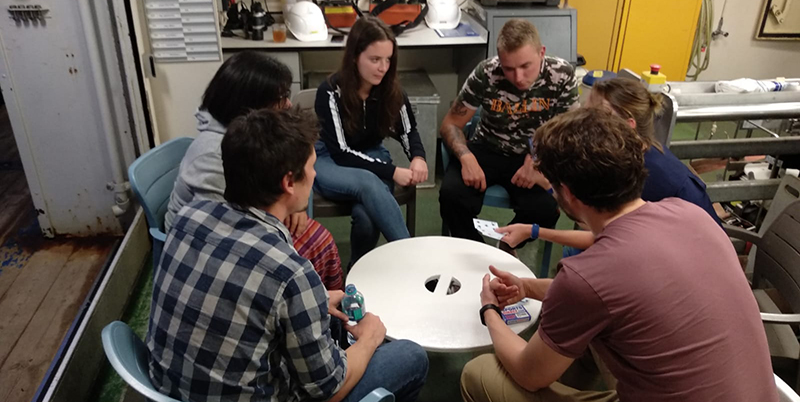
So why are we here? Not only because these Namibian waters offer a mouth-watering biogeochemical system for earth scientists who study the oxygen depletion in the waters below them from the safety of the ship. Not only because it is a rather unique opportunity to find RV Pelagia of the Royal Netherlands Institute for Sea Research (NIOZ) this far from its home on the Dutch island of Texel. There is more: oxygen depletion and its impacts on organisms is a fast-growing, in part man-made, phenomenon in coastal waters all over the world. To understand how oxygen depletion will impact these coastal waters, large naturally oxygen-depleted systems such as the Namibian waters that we are visiting are an interesting natural laboratory. Furthermore, large areas of Earth’s oceans have at some point in history experienced oxygen depletion. To know how to scan sediment records for such periods, we need to understand the biogeochemical fingerprint they leave behind. We will not only characterize the dissolved and particulate species in the water and sediment, but we will also investigate how microorganisms use and recycle essential elements. There will be no shortage of samples or data.
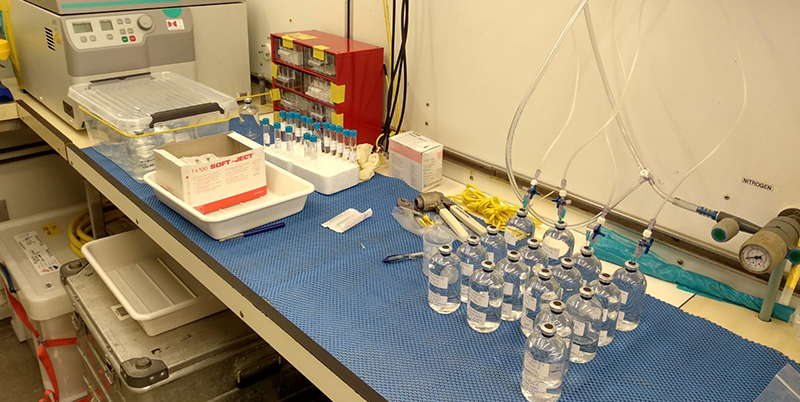
I am the chief scientist of our crack research team, which means running around the ship and back and forth between deck and bridge to get things organized, together with NIOZ colleagues Darci Rush and Zeynep Erdem. Exciting times! But for now, we are still cruising from Cape Town to Walvis Bay to pick up our collaborator Veronica from the University of Namibia. A transit with some breath-taking views and lot of seals and dolphins. After that, mayhem starts with CTD deployments, multicores, piston cores, in-situ pumps, on-deck incubations and loads of sample processing. These days are characterized by preparations (which places to sample exactly, when, for how long, etc.) and relaxation (exercise in the gym, card games, science presentations). Over the coming weeks, the scientific crew and I will keep you updated on our work, hopes, dreams and long, long days of experiments. So long for now!
Peter Kraal – marine biogeochemist at Royal NIOZ
